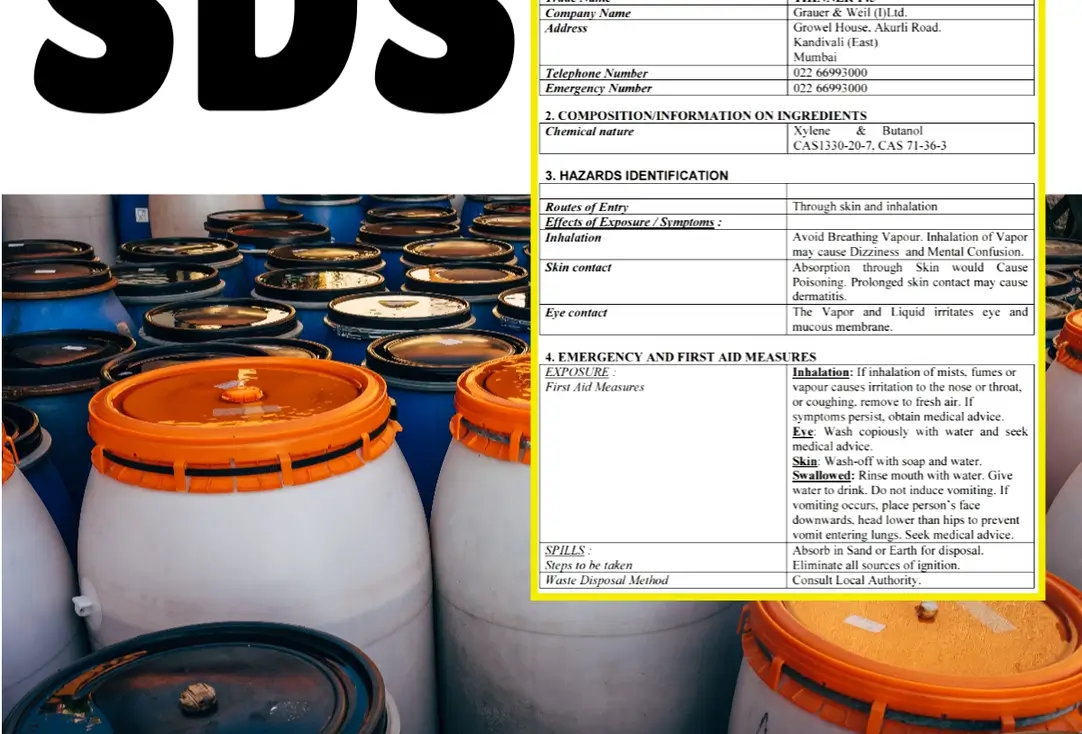SDSs are the key documents in chemical safety. They provide comprehensive information about chemicals to ensure safe handling, storage, and emergency measures.
According to the 2012 revision of the Hazard Communication Standard (HCS) (29 CFR 1910.1200(g)), chemical manufacturers, distributors, and importers must give downstream users Safety Data Sheets (SDSs), formerly known as Material Safety Data Sheets or MSDSs, for each hazardous chemical in order to inform them of the risks involved.
Although the SDSs must now be provided in a standard, user-friendly, 16-section format, the information they include is essentially the same as that of the MSDS. This brief offers instructions to help employees who handle dangerous chemicals learn the format and comprehend the information contained in SDSs.
The SDS contains details about each chemical’s characteristics, potential health, safety, and environmental risks, as well as preventive measures and safety measures for handling, storing, and transporting the
16 Sections of an SDS (Safety Data Sheet)
The following are the 16 sections of an SDS and what each section represents:
1. Identification
Purpose: To identify the chemical, its uses, and supplier details.
Details Included:
- Product name and other identifiers.
- Recommended uses and restrictions.
- Manufacturer or distributor contact information: address, phone number, and emergency number.
2. Hazard(s) Identification
Purpose: The section outlines the chemical hazards and the corresponding warning information.
Information to Provide:
- Hazard classification, such as flammable, and toxic.
- Signal words, such as Danger and warning.
- Hazard statements and precautionary statements.
- Pictograms, GHS format.
3. Composition/Information on Ingredients
Purpose: The chemical ingredients are listed with their concentrations.
Details to Include:
- Chemical name, CAS number, and other unique identifiers.
- Impurities and stabilizing additives.
4. First-Aide Measures
Purpose: Procedures for exposure are outlined.
Details to Include:
- Symptoms of exposure.
- First-aid measures by route of exposure (inhalation, skin contact, eye contact, ingestion).
- Immediate medical care recommendations.
5. Fire-Fighting Measures
Purpose: Guidelines on extinguishing a fire in the chemical.
Information to include:
- Suitable and unsuitable extinguishing media.
- Special hazards arise from the chemical-for example, toxic gases.
- Special protective equipment for firefighters.
6. Accidental Release Measures
Purpose: How to manage spills, leaks, or releases.
Information to include:
- Emergency procedures and instructions on evacuating.
- Methods for containment and cleanup.
- Environmental precautions.
7. Handling and Storage
Purpose: It includes safe handling and storage.
Information to be Included:
- Precautions for safe handling include all incompatibilities, for example.
- Conditions for safe storage; include incompatibles, and any specific storage conditions such as temperature and humidity range.
8. Exposure Controls/Personal Protection
Purpose: Lists exposure limits and protective measures.
Information to be Included:
- OSHA PELs, ACGIH TLVs.
- Recommended engineering controls.
- PPE requirements.
9. Physical and Chemical Properties
Purpose: The chemical and physical characteristics are described.
Information to be Included:
- Appearance (color, physical state).
- Odor, odor threshold.
- Melting/freezing point, boiling point.
- Flammability, vapor pressure, density.
10. Stability and Reactivity
Purpose: Provides stability information and reactivity risks.
Details Included:
- Reactivity and chemical stability under normal conditions.
- Conditions to avoid, such as heat and shock.
- Incompatible materials and hazardous decomposition products.
11. Toxicological Information
Purpose: Details of health effects and toxicity data.
Details Included:
- Routes of exposure, such as inhalation and ingestion.
- Symptoms and delayed effects.
- Numerical measures of toxicity, such as LD50 values.
12. Ecological Information
Purpose: Discusses environmental impacts.
Details Included:
- Ecotoxicity, including effects on aquatic and terrestrial organisms.
- Persistence and degradability.
- Bioaccumulation potential and mobility in soil.
13. Disposal Considerations
Purpose: Outlines proper disposal practices.
Details Included:
- Disposal methods for the chemical and contaminated packaging.
- Regulatory disposal guidelines.
14. Transport Information
Purpose: Provides transport classification and safety.
Details Included:
- UN number and proper shipping name.
- Transport hazard class.
- Packaging group, environmental hazards, special precautions.
15. Regulatory Information
Purpose: Lists safety, health, and environmental regulations.
Details Included:
- Chemical-specific regulations, such as OSHA, EPA, and EU standards.
- Inventory lists and restrictions.
16. Other Information
Purpose: To provide additional relevant details.
Details Included:
- Date of the last SDS revision.
- SDS preparation information.
- References or disclaimers.
Conclusion
Each section of the SDS provides the user and responder with valuable information relative to chemical safety. Understanding those sections aids in compliance with regulations like OSHA’s Hazard Communication Standard and adds to workplace safety. Always review an SDS before using or handling any chemical.
Related Posts
Who is Responsible for Providing SDS (Safety Data Sheet) in the Workplace
10 Best SDS Authoring Software
